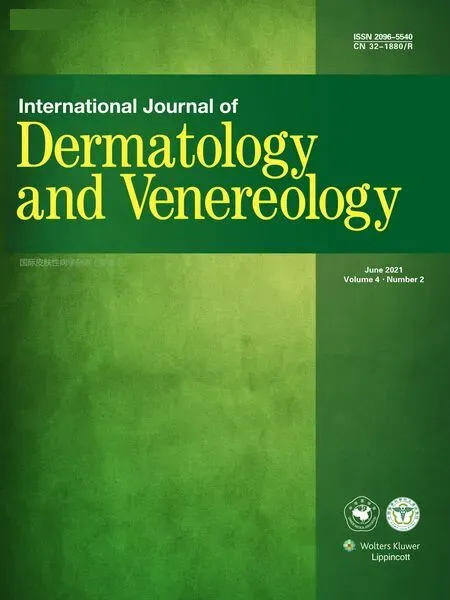Piloleiomyoma
Zhen-Zhen Yan,Xin Sun,Ming Zhang,Jian-Min Chang,Yan-Qing Gao,*
1Department of Dermatology,Capital Medical University You An Hospital,Beijing 100069,China;2Department of Dermatology,Beijing Hospital,National Center of Gerontology,Beijing 100730,China.

Figure 1.Histologic examination of piloleiomyoma.(A)Mild epidermal hyperplasia with a proliferation of pink interlacing smooth muscle bundles in the dermis(H&E,×40).(B)The nuclei are elongated with blunt ends and perinuclear vacuoles typical of smooth muscle cells(H&E,×200).
Histopathology
Cutaneous piloleiomyoma(PLM),angioleiomyoma,and genital leiomyoma are variants of superficial cutaneous leiomyoma(CL).The classic appearance of a CL on hematoxylin and eosin staining is an unencapsulated,circumscribed dermal tumor composed of interlacing fascicles of spindle cells with a moderate amount of eosinophilic cytoplasm and a blunt-ended,elongated,cigar-shaped nucleus with perinuclear halos on crosssection;there is sometimes nuclear pleomorphism or a small number of mitoses,but the tumor retains its benign character(Fig.1A).1
There are certain characteristics that distinguish PLMs from other CLs.PLMs have varying degrees of epidermal hyperplasia and epidermal basal pigmentation,while this is rare in other variants of CLs.The presence of entrapped hair follicles and eccrine glands is also very suggestive of a PLM.1Secondary histopathological changes such as hyalinization,myxoid changes,calcification,and cystic degeneration are less frequently detected in PLMs than in angioleiomyomas,while perivascular lymphocytic infiltrates and extracellular melanin deposition in the papillary dermis are detected in about 50% of PLMs.1
On immunohistochemical examination,PLMs are positive for smooth muscle markers,including actin,α-SMA,calponin,and desmin,and are negative for S-100.1Smooth muscle fibers are revealed on routine smooth muscle stains,including Masson’s trichrome,aniline blue,von Gieson,and phosphotungstic acid hematoxylin.1
Clinical features

Figure 2.Clinical presentation of piloleiomyoma.Solitary redyellowish papules are located on the chest.
CLs were first described by Virchow in 1854,and account for nearly 5%of all leiomyomas.2The most common type of CL in Caucasians is PLM,which arises from the arrector pili muscle of the pilosebaceous unit.PLM usually presents as multiple,firm,skin-colored to light brown papules or nodules,ranging in diameter from 2 to 20mm(Fig.1B).Various patterns and distributions of PLM have been described,such as segmental or zosteriform,bilateral,symmetrical,linear,or disseminated.3Most PLMs are tender or painful,which may be spontaneous or induced by cold,emotions,touch,trauma,or pressure.The pathogenesis of the pain associated with PLMs may be local pressure on the cutaneous nerves,contraction of the arrector pili muscle,or injury.The most common sites of PLM are the extremities,particularly the extensor surfaces,followed by the trunk,while the head and neck area is rarely affected.PLM may present as a solitary lesion(especially in women)or multiple lesions(especially in men).4PLMs can develop in the second or third decade of life(Fig.2).
Treatment for PLMs is often necessary due to pain or sensitivity.PLM treatments comprise drugs that block smooth muscle contractions(such as nifedipine,phenoxybenzamine,and nitroglycerin doxazosin),and drugs that target nerve activity(such as gabapentin and topical analgesics).5Surgical excision is the treatment of choice for a painful solitary leiomyoma.However,destructive methods such as electrodessication,radiotherapy,and carbon dioxide laser ablation have also been used with varying results.6Botulinum toxin injections may effectively treat PLM by inhibiting the release of certain neuropeptides,which reduces central pain signals.5Cryotherapy reduces pain by destroying nerve cells rather than tumor cells.6
The differential diagnoses for PLMs include dermatofibroma,cutaneous schwannoma,neurofibroma,eccrine spiradenoma,glomus tumor,angiolipoma,spontaneous keloid eruption,and post-acne keloid scar.3,4
The association between CLs and an inherited susceptibility to renal cancer was first recognized in 2001.PLMs are the most common type of leiomyomas seen in hereditary leiomyomatosis and renal cell cancer syndrome.2At-risk members of families with hereditary leiomyomatosis and renal cell cancer syndrome who test positive for the family’s germline fumarate hydratase mutation should undergo annual MRI surveillance beginning at the age of 8 years.2
- 国际皮肤性病学杂志的其它文章
- The Power of Molecular Genetics in Understanding Heritable Skin Disorders:Introduction to the Special Theme on Genodermatosis
- Eruptive Cutaneous Collagenoma:Report of Two Cases
- Urethral Orifice Genital Herpes Caused by HSV-1 in a Female Patient:A Case Report
- Clinical Manifestations of Adult Langerhans Cell Histiocytosis with Multisystem Involvement Successfully Treated Using Chemotherapy
- The Association of Psoriasis and Obesity:Focusing on IL-17A-Related Immunological Mechanisms
- Resveratrol Inhibits Secretion of Interleukin 8 by Regulation of Autophagic Flux in Ultraviolet B-stimulated Keratinocytes

